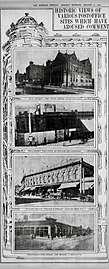
Broadway, until 1890 Fort Street, is a thoroughfare in Los Angeles County, California, USA. The portion of Broadway from 3rd to 9th streets, in the Historic Core of Downtown Los Angeles, was the city's main commercial street from the 1910s until World War II, and is the location of the Broadway Theater and Commercial District, the first and largest historic theater district listed on the National Register of Historic Places (NRHP). With twelve movie palaces located along a six-block stretch of Broadway, it is the only large concentration of movie palaces left in the United States.

Downtown Long Beach is the heart of Long Beach, California, United States, and is the location for most of the city's major tourist attractions and municipal services. It is also the location for numerous businesses. There are many hotels and restaurants in the area that serve locals, tourists, and convention visitors.

The Los Angeles Chinese massacre of 1871 was a racial massacre targeting Chinese immigrants in Los Angeles, California, United States that occurred on October 24, 1871. Approximately 500 white and Hispanic Americans attacked, harassed, robbed, and murdered the ethnic Chinese residents in what is today referred to as the old Chinatown neighborhood. The massacre took place on Calle de los Negros, also referred to as "Negro Alley". The mob gathered after hearing that a policeman and a rancher had been killed as a result of a conflict between rival tongs, the Nin Yung, and Hong Chow. As news of their death spread across the city, fueling rumors that the Chinese community "were killing whites wholesale", more men gathered around the boundaries of Negro Alley. A few 21st-century sources have described this as the largest mass lynching in American history.
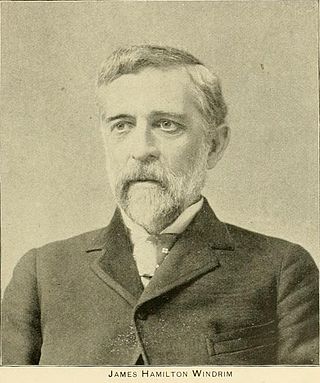
James Hamilton Windrim was a Philadelphia architect who specialized in public buildings, including the Masonic Temple in Philadelphia and the U.S. Treasury. A number the buildings he designed are on the National Historic Landmarks and/or the National Register of Historic Places, including the Masonic Temple in Philadelphia and the National Savings and Trust Company building in Washington, DC.
Mission Acres was a historic rural community in the northern San Fernando Valley. Its historic boundaries correspond roughly with the former community of Sepulveda and present day community of North Hills within Los Angeles, California. The community's western border was Bull Creek, which flowed south out of Box Canyon in the western San Gabriel Mountains near San Fernando Pass.
The California Digital Newspaper Collection (CDNC) is a freely-available, archive of digitized California newspapers; it is accessible through the project's website. The collection contains over six million pages from over forty-two million articles. The project is part of the Center for Bibliographical Studies and Research (CBSR) at the University of California Riverside.

The Aguaje de Centinela, or Centinela Springs, was a valued source of local spring water for Rancho Aguaje de la Centinela and what is now southwest Los Angeles and Inglewood in Southern California.
Albert Etter (1872–1950) was an American plant breeder best known for his work on strawberry and apple varieties.

Edward Kern (1860–1912) was a soldier who served in the U.S. war against Geronimo. He was a 19th and 20th century Los Angeles, California, politician and police chief who became an alcoholic and committed suicide.
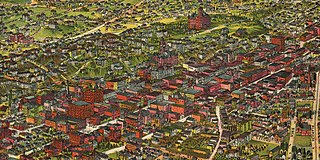
The late-Victorian-era Downtown of Los Angeles grew year by year, around 1880 centered at the southern end of the Los Angeles Plaza area, and over the next two decades, extending south and west along Main Street, Spring Street, and Broadway towards Third Street. Most of the 19th-century buildings no longer exist, surviving only in the Plaza area or south of Second Street. The rest were demolished to make way for the Civic Center district with City Hall, numerous courthouses, and other municipal, county, state and federal buildings, and Times Mirror Square. This article covers that area, between the Plaza, 3rd St., Los Angeles St., and Broadway, during the period 1880 through the period of demolition (1920s–1950s).

7th Street is a street in Los Angeles, California running from S. Norton Ave in Mid-Wilshire through Downtown Los Angeles. It goes all the way to the eastern city limits at Indiana Ave., and the border between Boyle Heights, Los Angeles and East Los Angeles.
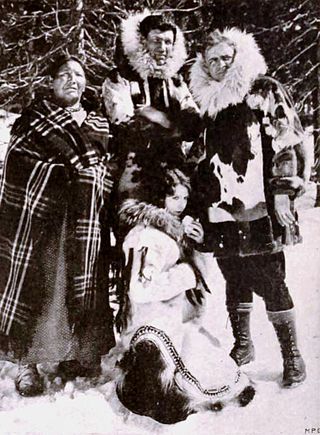
Clarence E. Shurtleff was involved in the film business in the U.S. including as a producer for his namesake film company, C. E. Shurtleff, Inc.

Robert Whitaker was a Baptist minister and political activist born in 1863 in Padiham, Lancashire, England. He died in Los Gatos, CA in 1944. In 1869 he moved with his family to the United States. After attending Andover Newton Theological School he went on to hold several pastorates in the western United States including Oakland, CA, Los Gatos, CA., and Seattle, WA.

Retail in Southern California dates back to its first dry goods store that Jonathan Temple opened in 1827 on Calle Principal, when Los Angeles was still a Mexican village. After the American conquest, as the pueblo grew into a small town surpassing 4,000 population in 1860, dry goods stores continued to open, including the forerunners of what would be local chains. Larger retailers moved progressively further south to the 1880s-1890s Central Business District, which was later razed to become the Civic Center. Starting in the mid-1890s, major stores moved ever southward, first onto Broadway around 3rd, then starting in 1905 to Broadway between 4th and 9th, then starting in 1915 westward onto West Seventh Street up to Figueroa. For half a century Broadway and Seventh streets together formed one of America's largest and busiest downtown shopping districts.

The HotelLankershim was a landmark hotel located at Seventh Street and Broadway in downtown Los Angeles, California in the United States. Construction began in 1902 and was completed in 1905. The building was largely demolished in the early 1980s following structural damage caused by the 1971 Sylmar earthquake. The "posh" hotel had nine stories, 300 rooms and two dining rooms.

The second Los Angeles federal building in Los Angeles County, California, more formally the United States Post Office and Courthouse, was a government building in the United States was designed by James Knox Taylor ex officio and constructed between 1906 and 1910 on the block bounded by North Main, Spring, New High, and Temple Streets. The location was previously known as the Downey Block.
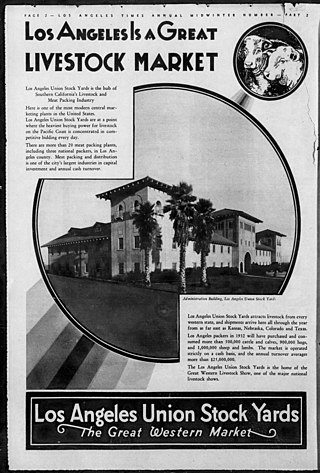
The Los Angeles Union Stock Yards were a livestock market and transfer station in the so-called Central Merchandising District south of downtown Los Angeles in Los Angeles County, California. The stock yards closed in 1960 and the facilities were demolished and replaced with other industrial warehouses.

The Tajo Building was a six-story office building on the northwest corner of First and Broadway in downtown Los Angeles, developed by Simona Martinez Bradbury. The building, named for the Bradbury family's Tajo silver mine in Mexico, was variously home to USC Law School, the Los Angeles Stock Exchange and, for the first decade of the 1900s, the United States District Court for the Southern District of California.




